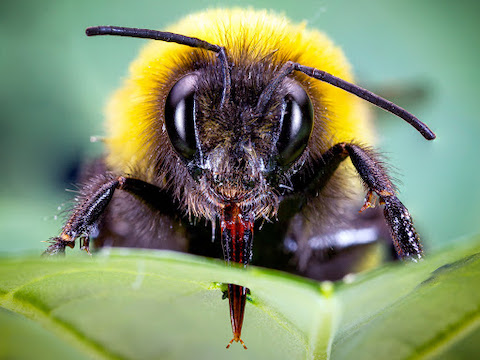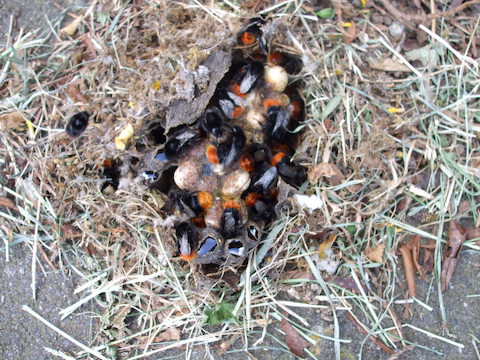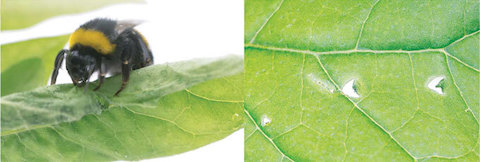
You may have heard that bumblebees shouldn’t be able to fly. That’s a myth actually, as any flying bumblebee will tell you. The science of their flight is now understood.
But the bees hold another mystery that could affect human agriculture.
Bumblebees hibernate over winter, and when they emerge in the spring, they’re hungry.
But what if the plants they rely on for pollen and nectar aren’t yet producing? The bees actually force them to do it.
Like their honeybee cousins, bumblebees scout their environment to identify the best flowers.
Scientists noticed a strange behavior on plants that were not flowering: the bees bit a pattern of tiny holes in the leaves. Soon after, the plants bloomed—up to 1 month earlier than normal.
Once they started flowering, the bees stopped biting them and started harvesting the nectar.
Researchers tried to replicate the bees’ technique by making their own tiny holes in the leaves of different plants. They bloomed earlier too, but only by about a week.
How the bees produced their better results is still a mystery. Perhaps they’re leaving behind a biochemical that accelerates the plants’ chemistry.
If humans can figure out how they do it, it’s possible we could force crops to bloom earlier, extending growing seasons, perhaps adding another growing season in the year, thus increasing annual crop yields.
Leave it to the bumblebee, that impossible flyer, to show us how to bend the laws of nature.
Background
Synopsis: The annual emergence of pollinators coincides with the bloom of flowering plants each spring. These symbionts evolved to depend upon each other and must stay synchronized to survive. Recently, scientists discovered that in some cases, this synchronized symbiosis is not coincidental—it is deliberate. When hungry bumblebees puncture the leaves of certain plants, it causes them to bloom up to a month earlier than normal to provide the nectar and pollen the insects need. This mysterious bumblebee superpower could benefit agriculture by extending growing seasons, but scientists still need to work out the details.
- One of the longest-standing symbiotic relationships on the planet occurs between flowering plants and insects—it started more than 130 million years ago.
- Angiosperms and pollinators evolved together. Insects, birds and other pollinators need nectar and pollen; plants need pollination. Without each other, they would have evolved into very different organisms.
- Certain plants have adapted to accommodate specific pollinators. Flower size and shape and even bloom timing have evolved to create advantages for certain pollinators.
- With this specialization, the synchronization of pollinator availability and blooming is critical.
- Sometimes pollinators emerge from hibernation earlier in the season than plants are ready to bloom and must rely on stored reserves of food from the prior season while awaiting fresh nectar and pollen production to feed themselves and their larvae.
- But recent observations of bumblebees have shown that these insects can manipulate certain plants to bloom on their schedule.
- Bumblebees belong to the same family as honeybees but a different genus.
- In the 1800s, the genus Bombus was named for the buzzing sound bumblebees make as they investigate a garden. There are more than 250 Bombus species.
- Originally known as “humbylbees” in writings from the 1400s, their buzzing caused some authors in the 1500s to refer to them as “bombyll” bees. An old provincial name for the insects was “Dumbeldor.”
- Their sound was immortalized in the famous Nikolai Rimsky-Korsakov interlude “Flight of the Bumblebee,” written ca. 1900.
- Bumblebees are both similar to and different from their honeybee cousins.
- They tend to inhabit higher altitudes or higher latitudes, especially in the Northern Hemisphere.
- Like honeybees, bumblebees collect both nectar and pollen for food, surveying the bounty of the landscape and marking blooms they have visited with their scent.
- Bumblebees tend to nest underground in abandoned burrows or sheltered spaces in the shade, and their nests usually only last one season.
- Different species of Bombus make different sized nests, with colonies usually ranging from 50–400 bees. Honeybee colonies are orders of magnitude larger, with populations of 50,000 or more.
- Bumblebees store their honey in randomly organized wax honeypots within the hive—they do not make orderly hexagonal honeycombs like honeybees.

- Scientists tend to observe bees as they interact with flowers, but one scientist at ETH Zurich became curious about what some bumblebees were doing when there were no flowers available in a greenhouse.
- The student, Foteini Pashalidou, was involved in a different experiment involving how bees respond to plant smells.
- She noticed the bees busily cutting holes in the leaves of certain plants.
- But they weren’t consuming the leaf material or using it for anything. They were simply cutting holes. What were they doing?
- Because bumblebees establish new hives each year, they desperately need pollen for their young early in the season.
- The researchers suspected the bees might be attempting to cause stress that would induce the plants to flower.
- They quickly set up a series of experiments:
- They set up mesh cages containing tomato and black mustard plants that had not yet flowered.
- Then they introduced buff-tailed bumblebee (Bombus terrestris) colonies that had been deprived of pollen for 3 days into the cages, removing plants after the bees had made 5–10 holes in their leaves.
- Compared to control plants, the bee-punctured plants bloomed earlier: the black mustard plants bloomed 2 weeks earlier, and the tomato plants bloomed a full month earlier.
- The researchers also placed pollen-fed bumblebee colonies into mesh cages with the same types of plants and found that these worker bees did not damage the leaves. The pollen-deprived bees, on the other hand, immediately set to puncturing leaves in other cages.
- The pollen-deprived bees were allowed to forage broadly, but they preferred to damage the leaves of plants closest to their hives until local flowers came into bloom to supplement their diet.

- When hungry, these Swiss bumblebees deliberately accelerated the blooming cycle of certain plants, especially those nearest to their hives.
- They stopped the puncturing behavior when the pollen supply was sufficient for their needs.
- The leaf-cutting behavior was documented in three species of bumblebees, but it is not yet known if it is common to other species. However, we do know that honeybees do not use this strategy.
- The researchers tried to mimic the punctures and found that the plants bloomed slightly earlier (8 days earlier for the black mustard and 5 days earlier for the tomatoes), but much later than those punctured by the bumblebees.
- Scientists still have work to do to solve the mystery of the bumblebee's mastery at overriding the seasonal rhythm of plants critical to their survival.
- They have hypothesized that the bees may leave behind a biochemical cue in the cut leaves that initiates the blooming response.
- Learning from these busy bumblebees could enable humans to encourage plants to bloom early, extending growing seasons and improving crop yields.

